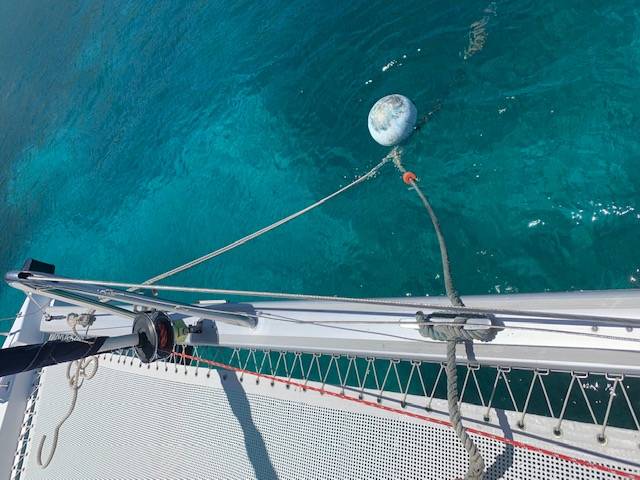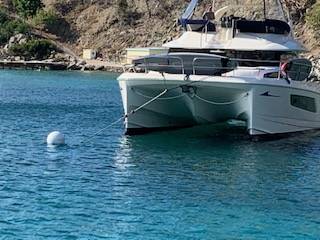Posted By: GeorgeC1
Avoiding clanging balls, - 06/03/2019 03:27 PM
I posted on other threads about how to tie off to the balls if winds are light or current might be a factor. Doing it this way prevents the ball from banging the hulls or going under the bridgedeck. Here is a pic if I have enough bandwidth to send.
G

Posted By: GeorgeC1
Re: Avoiding clanging balls, - 06/03/2019 09:15 PM
Here is a picture of how never to tie off to a Mooring ball. If a big wind came up the boat will tack back and forth and saw right threw the rope. You have no redundancy. If you want to tie directly to the pennant loop you need a different line from each cleat. That will prevent sawing and gives you a backup should one line break.

Posted By: Deepcut
Re: Avoiding clanging balls, - 06/03/2019 09:43 PM
Yep and Yep("Oh NO!"). On number 2, aways stay up wind from these guys. Had a DYC behind me at Anegada and they did the #2 method. Thought I would politely give some education... Dingied over and they spoke German(and very little English).. I speak English and absolutely no German.... Fortunately no bad outcome.
Posted By: NCSailor
Re: Avoiding clanging balls, - 06/04/2019 12:00 AM
The number 2 method is better than the one where the pennant eye is just attached on the cleat.
Posted By: warren460
Re: Avoiding clanging balls, - 06/04/2019 12:49 AM
George, I thought your title “avoiding clanging balls” had to do with STD’s
Posted By: Pearson
Re: Avoiding clanging balls, - 06/11/2019 05:45 PM
NCSailor....I actually saw a guy do this in Trellis! The pennant eye was right on deck. We thought this was a joke...stayed like this all night.
Posted By: Eagleboy
Re: Avoiding clanging balls, - 06/18/2019 04:51 PM
Not clear to me how this is tied off from the picture. I usually run lines from both sides through the eye and doubled back to the same side. Is there something different going on here?
ETA: I see there is only one line on the starboard side but not sure exactly what they did. Any help would be appreciated. We had noisy balls at Cooper our last trip and heading back down in July...
Posted By: Pearson
Re: Avoiding clanging balls, - 06/18/2019 06:47 PM
Looks to me like he has a single line, thru the eye running from stbd to port. No redundancy. The way you describe is correct.
Check my ticker. See you there!
Posted By: JasonHelmbrecht
Re: Avoiding clanging balls, - 06/18/2019 06:57 PM
Looks to me like he has a single line, thru the eye running from stbd to port. No redundancy. The way you describe is correct.
Check my ticker. See you there!
No. The pendant is directly on the stb cleat and the port cleat has a line run directly to the eye on the ball. This is how I was taught to do it in ASA class.
Posted By: captdennyj
Re: Avoiding clanging balls, - 06/18/2019 07:28 PM
We sail a 36 foot monohull, and absolutely believe in having two separate double bridles. Like the OP, we ;like have a back up just in case. I know zip about catamarans , but very much like having a back up line securing us
to the mooring.. .
We use heavy dock lines, one from the port bow cleat, thru the eye of the mooring pennant , and back to the same port cleat, and then
a different dock line run from the starboard bow cleat, thru the eye of the pennant back to the starboard bow cleat. We secure both with proper cleat hitches and have had no problem with lines chafing thru or rubbing against the bow
anchor. .
.
We also keep a short painter with the eye just a couple of feet from the bow, away from the anchor, with both bridles equal in length. .Many of the bare boat companies, require double bridles when mooring a monohull. Most of the
bareboat and charter captains follow this procedure.
And, we like to we check the moored bridle lines for chafe , and the security of the painter at the mooring ball as well, occasionally, During the the day, and in the evening. Just an easy walk around .the entire boat
looking for anything not shipshape.
-------------------------------------------------------------------------------------------------------------------------------------------------------------------------------------------------------------------------
As the OP mentioned, we see many boats sailing on their mooring or at anchor, with about 1/3 of the mainsail still up, catching the wind .
Years ago, it was some times difficult to get my body up high enough to reach the head of the sail to flake the luff and pull the main all the way down. Back then, I used to climb up the mast , like a monkey scaling a coconut tree, until
one day, as I was precariously clinging to the mast with one arm, feet gripping for a purchase, while with my free arm fighting to bring the luff of the main sail down totally into the stack pack.
Erica shouts up to me from the cockpit......" Ahh, HOW ABOUT USING A BOAT HOOK ?
Bloody well Brilliant ! .
Gold stars and atta-girls for Erica. Another way to keep life easy on a sailing vessel . The only thing is , in recent years I have no longer been entertaining the mooring field of boats with my mast climbing antics.
The admiral was right on, I now just hook the luff slides and the head board of the main that I could not reach, and with the boat hook down she comes with both of my feet planted securely on the deck.
Once the main is fully tucked down in the stack pack, I can use the boat hook to then snag the main halyard and bring it down with a half turn under a mast cleat, then winch in the halyard tight , And then with a small extra line,
run from the shroud I can secure the main halyard away from the mast in order to stop any annoying mast slap by the halyard.
Makes for a peaceful night's sleep not only for us, but for our close by moored neighbors as well.
We were at Cooper again, just a few weeks ago, and no problem, but we probably had enough wind to overcome the opposing current . no banging of anything, and no thumping of the mooring ball against the hull.
.Just FYI


